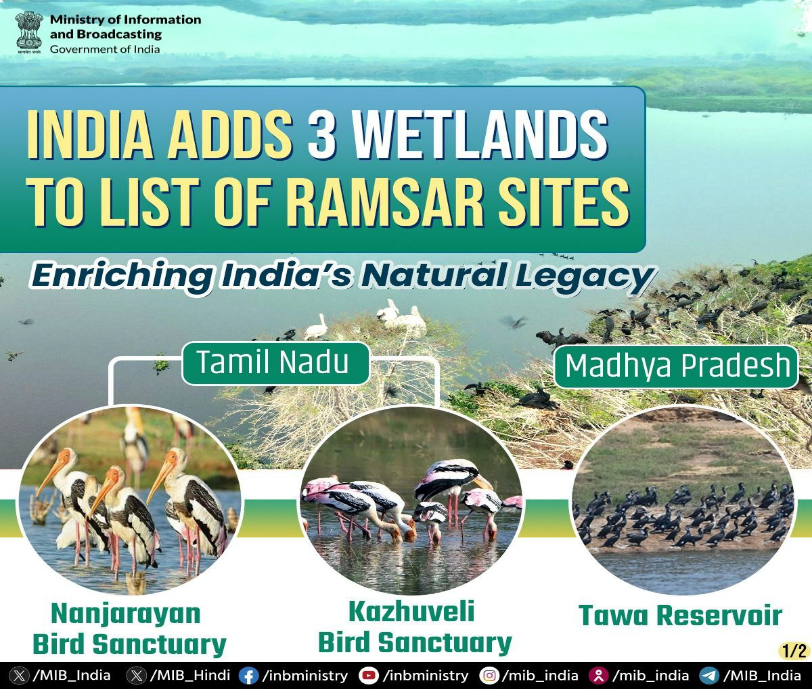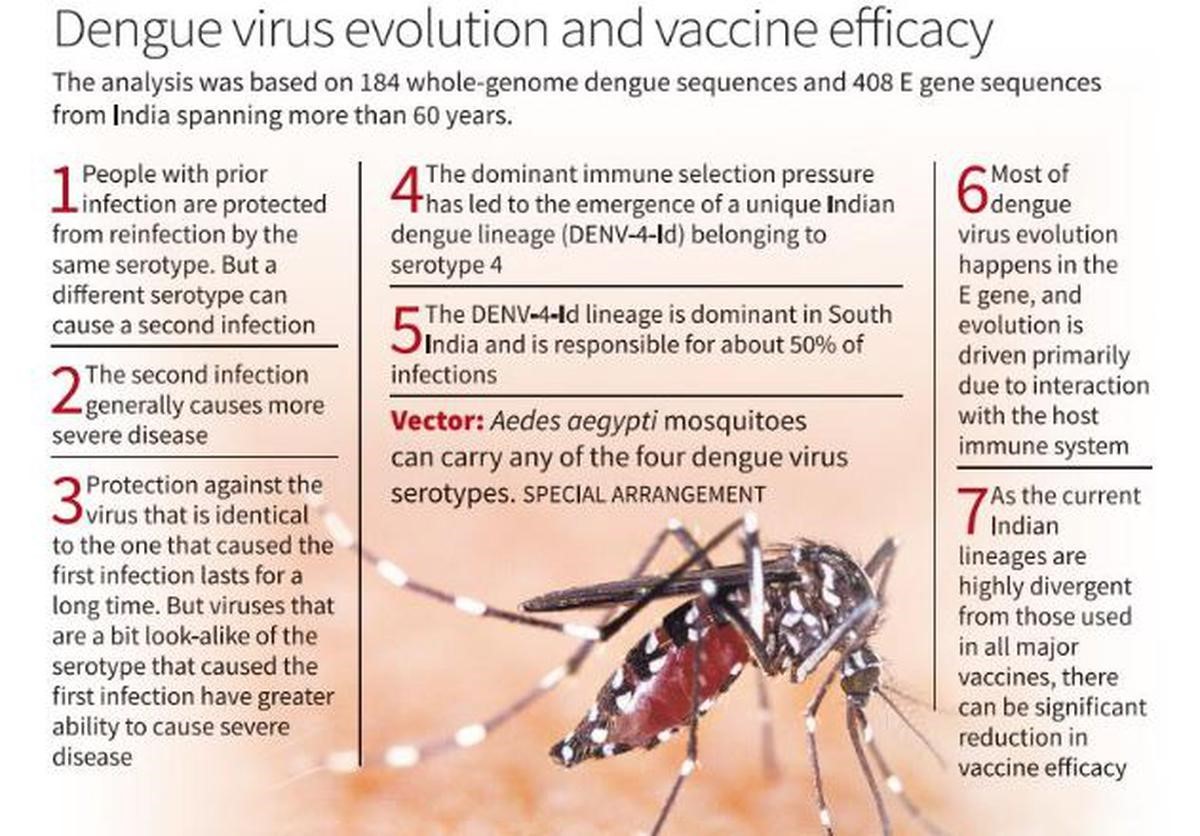New Ramsar wetland sites added in India
CONTEXT: Addition of New Sites:
- India has added three new wetlands to its Ramsar site list: Nanjarayan and Kazhuveli bird sanctuaries in Tamil Nadu and the Tawa reservoir in Madhya Pradesh.
- This brings the total number of Ramsar sites in India to 85.
- Area Covered: The newly designated Ramsar sites increase the total area of Ramsar wetlands in India to 13,58,068 hectares.
- Ramsar Convention:
- India is a signatory to the Ramsar Convention, which was signed in Ramsar, Iran, in 1971 and India joined in 1982.
- From 1982 to 2013, India had 26 Ramsar sites. Between 2014 and 2024, 59 more sites were added.
- Current Distribution:
- Tamil Nadu has the highest number of Ramsar sites in India with 18, followed by Uttar Pradesh with 10.
- India’s Ramsar wetlands cover approximately 10% of the country’s total wetland area across 18 states.
- Global Comparison:
- India has the most Ramsar sites in South Asia, due to its geographical and tropical diversity.
- The United Kingdom has the highest number of Ramsar sites globally (175), followed by Mexico (142). Bolivia has the largest Ramsar site area (1,48,000 sq. km).
- Significance of Ramsar Designation:
- Being designated a Ramsar site enhances international visibility and can boost tourism potential.
- The designation does not necessarily provide additional international funding but requires national and state-level efforts for conservation.
- Wetlands must meet at least one of nine Ramsar criteria to qualify, such as supporting endangered species or being crucial for waterbirds and fish stocks.
Phase 3 clinical trial for India's indigenous dengue vaccine
- Initiation of Phase 3 Trial:
- The Indian Council of Medical Research (ICMR) and Panacea Biotec Ltd. have announced the start of the first Phase 3 clinical trial for a dengue vaccine in India.
- Vaccine Details:
- The vaccine being tested is DengiAll, an indigenous tetravalent dengue vaccine developed by Panacea Biotec.
- The vaccine uses the tetravalent dengue vaccine strain (TV003/TV005), originally developed by the National Institutes of Health (NIH), U.S.
- Trial Locations and Participants:
- The trial will take place across 19 sites in 18 states and Union Territories in India.
- It will involve over 10,335 healthy adult participants.
- The first participant was vaccinated at the Pandit Bhagwat Dayal Sharma Postgraduate Institute of Medical Sciences in Rohtak.
- Previous Trial Phases:
- Phases 1 and 2 of the clinical trials for this vaccine were completed in 2018-19 with promising results.
- Funding and Duration:
- The trial is funded by the ICMR with partial support from Panacea Biotec.
- Participants will be followed up for two years.
- Significance:
- This Phase 3 trial is a significant milestone in India’s efforts to combat dengue and showcases the country’s capabilities in vaccine research and development.
Union Health Minister J.P. Nadda emphasized the importance of this trial for public health and for India’s vision of self-reliance in the healthcare sector (Atmanirbhar Bharat).
About the Delhi Police officers and others who are being honored this Independence Day
Delhi Police Honorees:
- President’s Medal for Distinguished Service:
- Atmaram Vasudeo Deshpande: Joint Commissioner of Police (Operations), recognized for reviving the Jansunwai grievance redressal system.
- Shashi Bala: Retired Assistant Commissioner of Police (ACP), honored for her efficient management of VVIP routes and her role in self-defense training.
- Medals for Meritorious Service:
- Suman Goyal: Joint Commissioner of Police (Rashtrapati Bhawan), acknowledged for her role during the G20 Summit, managing foreign ministers, and implementing initiatives like the Udaan Project and pink cabs for women drivers.
- Rajneesh Garg: Deputy Commissioner of Police (DCP), awarded for his role as venue commander during the G20 Summit and ensuring VVIP security.
Arvind Kumar: ACP, recognized for key investigations including the Nina Berger murder case, Hari Nagar triple murder case, and bomb blast cases.
Study on Microbes in Microwave Ovens
Key Findings:
- Presence of Microbes:
- Microwave ovens, whether used in homes, offices, or laboratories, host diverse communities of microbes.
- This contradicts the belief that microwave radiation effectively eliminates bacteria, suggesting that microwave ovens are not necessarily cleaner than other kitchen surfaces.
- Microbial Diversity:
- Researchers sampled 30 microwave ovens from different settings (homes, labs, shared kitchens) and found 747 different genera of bacteria.
- Dominant Genera: Bacillus, Micrococcus, and Staphylococcus, which are commonly found on human skin and frequently touched surfaces.
- Potentially Harmful Bacteria: Klebsiella, Enterococcus, and Aeromonas, which can pose health risks.
- Differences by Microwave Type:
- Domestic and Shared-Use Microwaves: Higher abundance of human-skin bacteria.
- Laboratory Microwaves: Contained the most diverse range of bacteria, including “extremophiles” that can survive extreme conditions.
- Implications:
- Hygiene: The study highlights the need for regular cleaning of microwaves, as they can harbor potentially harmful microbes.
- Common Misconceptions: Microwave radiation does not ensure complete disinfection, so relying solely on microwaves for cleanliness is insufficient.
Study Methods:
- Sampling: Researchers collected samples from 30 microwave ovens.
- Culturing: Samples were cultured in Petri dishes to grow and identify bacteria.
DNA Sequencing: Used to further analyze and identify the bacterial species present.




